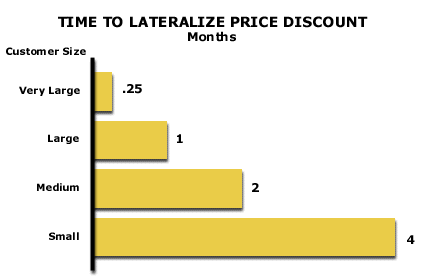Analysis 52: Time To Lateralize Price Discount
EXHIBITS:

| HOW TO INTERPRET THE ANALYSIS: This exhibit shows the time in months required for a price discount to spread throughout each customer size category in the marketplace. Once a new low price is established in a marketplace, this lower price, or its equivalent discount on the prior price, tends to spread, or lateralize, throughout the market. In this industry, virtually all Very Large customers receive the same discount, or the same new low price, within a week. Large customers receive the new discount within a month, while Medium and Small customers wait two and four months, respectively.
PURPOSE: This analysis quantifies the average time that a discount takes to spread to other members of a customer segment. Armed with this knowledge, the Company may slow the spread of price discounts to its smaller customers by insuring that their discounts do not exceed the price expected from the rate of price discount lateralization of the past. APPROACH: Each time the Company offers a discount in the market place, there is a tendency for that discount to spread to other members of the segment and then throughout the remainder of the market. In a Hostile marketplace, this tendency is very high. In a Hostile market, any discount given to one member of the segment is highly likely to spread (i.e. lateralize) to other members of the segment. This analysis measures the time from the establishment of a new low price in a customer segment until that same discount spreads through the other members of the segment. This analysis uses segmentation described by the customer Size/Role matrix, but other segmentations may also apply. The Company uses the results of this analysis to project the timing of the expected demands for lower prices that should come in each segment as a result of a discount offered to one of the larger competitors. |
|
Recommended Reading |
| For a greater overall perspective on this subject, we recommend the following related items:
Analyses: Symptoms and Implications: Symptoms developing in the market that would suggest the need for this analysis.
Perspectives: Conclusions we have reached as a result of our long-term study and observations.
|
